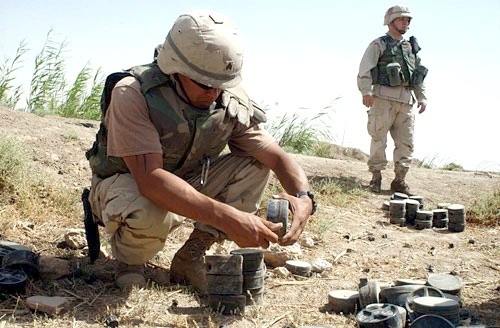Self-navigating trousers
Interview with
GPS isn't the only way to work out where you are: scientists are now working  on a design for self-navigating trousers that keep track of your movements and might even save your life. Nottingham University's Terry Moore gave Chris Smith the basics...
on a design for self-navigating trousers that keep track of your movements and might even save your life. Nottingham University's Terry Moore gave Chris Smith the basics...
Terry - This is a way of trying to do indoor navigation by using the human body itself and, in particular, by measuring what's happening in people's muscles in their legs as they're walking. By measuring those voltages in the muscles we can actually, therefore, learn what sets of signals mean somebody walks in a straight line or somebody goes round a curve.
Chris - Tell us how you do it?
Terry - At the moment we're doing it by sticking small sensors - the ones you might see in a hospital - onto people's legs, and we are measuring the voltages in various muscle groups. We've used motion tracking like you would see in Hollywood where they're making films and things, we've used motion tracking to know exactly how someone's moved and, at the same time, we've measured the voltage impulses in the muscles. And then using a technique we call machine learning, we then effectively produce a model that says this set of voltages corresponded with this motion.
So what we have then done to test it is then by once we had that model, then from a separate set of data, just fed in the voltages and therefore predicted what the model said where the person moved. And, of course, we then closed the loop by using the same tracking motion with that data set, we were able to test how closely our predictions, based just on the voltages in the muscles, how that would correspond with what actually happened.
Chris - So you get a fingerprint voltage profile, if you like, which must correspond to different patterns of muscle movements, which must correspond to movements people are making. That means you learn what voltages correspond to what movements people make for that person and then, after that, it's just a question of you can record the voltages to work out where someone's gone. You don't need any more precise measurements than that.
Terry - That's corrects, yeah. It's a dead reckoning technique as we call it in navigation. You're assuming you know where you started but then you're going to know how you moved forward to the next location from that. So the sort of applications we've got here, obviously we don't want to do this by sticking sensors onto people.
Chris - That was going to be my next question. It's not very aesthetic, it's not very fashionable to go around with cardiac ECG stickers stuck on your legs. So how could you get round this and why do you want to do this?
Terry - Okay. That's the next stage of the research we're doing now with colleagues working with the sensors. The goal is to build the sensors into the clothing, in the trousers in this case so you wouldn't have to stick the sensors on. It would be the trousers that you're wearing and it would be part of the garment.
Chris - What about if you wear shorts?
Terry - That's a good one. It wouldn't work so well for people in shorts. The sort of target people we're looking at are, people who wear uniforms is ideal, so people like firefighters, people like soldiers. That's why there's a lot of application interest in those areas so firefighters know where they are in a building and how to get out. So, if they relayed the information to each other, they'd know where their colleagues were, for example, in a fire situation to make it safer. And the same thing applies to soldiers in a war situation in a building.
Chris - So your trousers have a better idea where you are than you do?
Terry - Indeed, eventually yes. But obviously not the wrong trousers!
Chris - Indeed. Wallace and Gromit would have a heart attack wouldn't they? But why do we need this Terry? I've got a mobile phone that is pretty good - it got me here to the conference today. Why do you need trousers that can navigate your way around a building?
Terry - Because those two scenarios I've just said. In a war situation, in a combat situation, or in a fire situation you can't really rely on their being any infrastructure there. There may have been wifi and other sensitive signals in the building that you could position from. There could be GNSS there you could use, so like GPS that we'd use in our cars or smartphones. And again, even in a war situation it could be that those signals have been deliberately interfered with for one reason or another. So, when we're looking at people like firefighters or soldiers, we're trying to work with technology they can carry with them that don't rely on any other radio signals.
Chris - Could you use it also say for rehabilitation of people? If you can work out where someone's going, how fast they're doing it, what muscle groups they're using to do it, then working out how efficiently they're moving could be quite useful.
Terry - Yes, we've got a lot of interest in those areas as well. Certainly in terms of understanding how people are recovering from injury or even in sports training. Feeding it in there so it could provide vital information in all those areas.
- Previous Finding our way through space
- Next Driverless cars: are we ready?










Comments
Add a comment